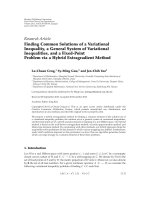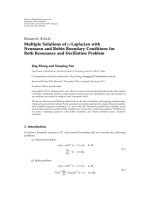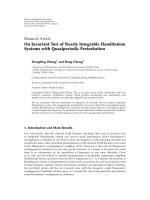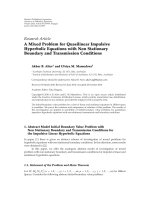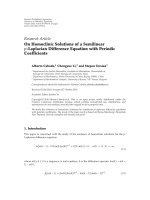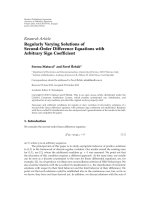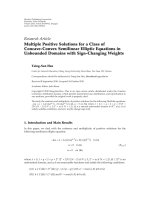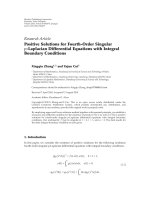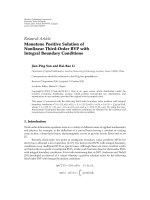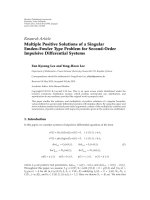Báo cáo sinh học: " Research Article Multiple Positive Solutions of Fourth-Order Impulsive Differential Equations with Integral Boundary Conditions and One-Dimensional p-Laplacian" ppt
Bạn đang xem bản rút gọn của tài liệu. Xem và tải ngay bản đầy đủ của tài liệu tại đây (578.22 KB, 26 trang )
Hindawi Publishing Corporation
Boundary Value Problems
Volume 2011, Article ID 654871, 26 pages
doi:10.1155/2011/654871
Research Article
Multiple Positive Solutions of Fourth-Order
Impulsive Differential Equations with Integral
Boundary Conditions and One-Dimensional
p-Laplacian
Meiqiang Feng
School of Applied Science, Beijing Information Science & Technology University, Beijing 100192, China
Correspondence should be addressed to Meiqiang Feng,
Received 2 February 2010; Revised 25 April 2010; Accepted 5 June 2010
Academic Editor: Gennaro Infante
Copyright q 2011 Meiqiang Feng. This is an open access article distributed under the Creative
Commons Attribution License, which permits unrestricted use, distribution, and reproduction in
any medium, provided the original work is properly cited.
By using the fixed point theory for completely continuous operator, this paper investigates the
existence of positive solutions for a class of fourth-order impulsive boundary value problems
with integral boundary conditions and one-dimensional p-Laplacian. Moreover, we offer some
interesting discussion of the associated boundary value problems. Upper and lower bounds for
these positive solutions also are given, so our work is new.
1. Introduction
The theory of impulsive differential equations describes processes which experience a sudden
change of their state at certain moments. Processes with such a character arise naturally
and often, especially in phenomena studied in physics, chemical technology, population
dynamics, biotechnology, and economics. For an introduction of the basic theory of impulsive
differential equations, see Lakshmikantham et al. 1; for an overview of existing results and
of recent research areas of impulsive differential equations, see Benchohra et al. 2.The
theory of impulsive differential equations has become an important area of investigation in
recent years and is much richer than the corresponding theory of differential equations see,
e.g., 3–18 and references cited therein.
Moreover, the theory of boundary-value problems with integral boundary conditions
for ordinary differential equations arises in different areas of applied mathematics and
physics. For example, heat conduction, chemical engineering, underground water flow,
thermo-elasticity, and plasma physics can be reduced to the nonlocal problems with integral
boundary conditions. For boundary-value problems with integral boundary conditions and
2 Boundary Value Problems
comments on their importance, we refer the reader to the papers by Gallardo 19, Karakostas
and Tsamatos 20, Lomtatidze and Malaguti 21, and the references therein. For more
information about the general theory of integral equations and their relation with boundary-
value problems, we refer to the book of Corduneanu 22 and Agarwal and O’Regan 23.
On the other hand, boundary-value problems with integral boundary conditions
constitute a very interesting and important class of problems. They include two, three,
multipoint and nonlocal boundary-value problems as special cases. The existence and
multiplicity of positive solutions for such problems have received a great deal of attention
in the literature. To identify a few, we refer the reader to 24–46 and references therein. In
particular, we would like to mention some results of Zhang et al. 34,Kangetal.44,and
Webb et al. 45.In34, Zhang et al. studied the following fourth-order boundary value
problem with integral boundary conditions
x
4
t
− λf
t, x
t
θ, 0 <t<1,
x
0
x
1
1
0
g
s
x
s
ds,
x
0
x
1
1
0
h
s
x
s
ds,
1.1
where λ is a positive parameter, f ∈ C0, 1 × P, P, θ is the zero element of E,andg, h ∈
L
1
0, 1. The authors investigated the multiplicity of positive solutions to problem 1.1 by
using the fixed point index theory in cone for strict set contraction operator.
In 44, Kang et al. have improved and generalized the work of 34 by applying
the fixed point theory in cone for a strict set contraction operator; they proved that there
exist various results on the existence of positive solutions to a class of fourth-order singular
boundary value problems with integral boundary conditions
u
4
t
a
t
f
t, u
t
, −u
t
b
t
g
t, u
t
, −u
t
, 0 <t<1,
a
1
u
0
− b
1
u
0
1
0
m
1
s
u
s
ds, c
1
u
1
d
1
u
1
1
0
n
1
s
u
s
ds,
a
2
u
0
− b
2
u
0
1
0
m
2
s
u
s
ds, c
2
u
2
d
2
u
1
1
0
n
2
s
u
s
ds,
1.2
where a, b ∈ C0, 1, 0, ∞ and may be singular at t 0ort 1; f,g : 0, 1 × P \{θ}×
P \{θ}→P are continuous and may be singular at t 0, 1,u 0, and u
0; a
i
,b
i
,c
i
,and
d
i
∈ 0, ∞,andρ
i
a
i
c
i
a
i
d
i
b
i
c
i
> 0, and m
i
,n
i
∈ L
1
0, 1 are nonnegative, i 1, 2.
More recently, by using a unified approach, Webb et al. 45 considered the widely
studied boundary conditions corresponding to clamped and hinged ends and many
nonlocal boundary conditions and established excellent existence results for multiple positive
solutions of fourth-order nonlinear equations which model deflections of an elastic beam
u
4
t
g
t
f
t, u
t
, for almost every t ∈
0, 1
,
1.3
Boundary Value Problems 3
subject to various boundary conditions
u
0
0,u
1
α
u
,u
0
0,u
1
0,
u
0
0,u
1
0,u
0
0,u
1
α
u
0,
u
0
0,u
1
α
u
,u
0
0,u
1
0,
u
0
0,u
1
0,u
0
0,u
1
α
u
0,
1.4
where αu denotes a linear functional on C0, 1 given by αu
1
0
usdAs involving a
Stieltjes integral, and A is a function of bounded variation.
At the same time, we notice that there has been a considerable attention on p-Laplacian
BVPs 18, 32, 35, 36 , 38, 42 as p-Laplacian appears in the study of flow through porous media
p 3/2, nonlinear elasticity p ≥ 2, glaciology 1 ≤ p ≤ 4/3, and so forth. Here, it is worth
mentioning that Liu et al. 43 considered the following fourth-order four-point boundary
value problem:
φ
p
x
t
w
t
f
t, x
t
,t∈
0, 1
,
x
0
0,x
1
ax
ξ
,
x
0
0,x
1
bx
η
,
1.5
where 0 <ξ,η<1, 0 ≤ a<b<1, and f ∈ C0, 1 × 0, ∞, 0, ∞. By using upper and
lower solution method, fixed-point theorems, and the properties of Green’s function Gt, s
and Ht, s, the authors give sufficient conditions for the existence of one positive solution.
Motivated by works mentioned above, in this paper, we consider the existence of
positive solutions for a class of boundary value problems with integral boundary conditions
of fourth-order impulsive differential equations:
φ
p
y
t
f
t, y
t
,t∈ J, t
/
t
k
,k 1, 2, ,m,
Δy
|
tt
k
−I
k
y
t
k
,k 1, 2, ,m,
y
0
y
1
1
0
g
t
y
t
dt,
φ
p
y
0
φ
p
y
1
1
0
h
t
φ
p
y
t
dt.
1.6
Here J 0, 1,φ
p
s is p-Laplace operator, that is, φ
p
s|s|
p−2
s, p > 1, φ
p
−1
φ
q
, 1/p
1/q 1, f ∈ CJ × R
,R
,I
k
∈ CR
,R
,R
0, ∞, t
k
k 1, 2, ,mwhere m is
fixed positive integer are fixed points with 0 t
0
<t
1
<t
2
< ···<t
k
< ···<t
m
<t
m1
1,
Δx
|
tt
k
x
t
k
− x
t
−
k
, where x
t
k
and x
t
−
k
represent the right-hand limit and left-hand
limit of x
t at t t
k
, respectively, and g, h ∈ L
1
0, 1 is nonnegative.
For the case of I
k
0,k 1, 2, ,m, problem 1.6 reduces to the problem studied
by Zhang et al. in 33. By using the fixed point theorem in cone, the authors obtained some
4 Boundary Value Problems
sufficient conditions for the existence and multiplicity of symmetric positive solutions for a
class of p-Laplacian fourth-order differential equations with integral boundary conditions.
For the case of I
k
0,k 1, 2, ,m, g 0,h 0, and p 2, problem 1.6 is
related to fourth-order two-points boundary value problem of ODE. Under this case, problem
1.6 has received considerable attention see, e.g., 40–42 and references cited therein.
Aftabizadeh 40 showed the existence of a solution to problem 1.6 under the restriction
that f is a bounded function. Bai and Wang 41 have applied the fixed point theorem and
degree theory to establish existence, uniqueness, and multiplicity of positive solutions to
problem 1.6. Ma and Wang 42 have proved that there exist at least two positive solutions
by applying the existence of positive solutions under the fact that ft, u is either superlinear
or sublinear on u by employing the fixed point theorem of cone extension or compression.
Being directly inspired by 18, 34, 43, in the present paper, we consider some existence
results for problem 1.6 in a specially constructed cone by using the fixed point theorem. The
main features of this paper are as follows. Firstly, comparing with 39–43, we discuss the
impulsive boundary value problem with integral boundary conditions, that is, problem 1.6
includes fourth-order two-, three-, multipoint, and nonlocal boundary value problems as
special cases. Secondly, the conditions are weaker than those of 33, 34,
46, and we consider
the case I
k
/
0. Finally, comparing with 33, 34, 39–43, 46, upper and lower bounds for these
positive solutions also are given. Hence, we improve and generalize the results of 33, 34, 39–
43, 46 to some degree, and so, it is interesting and important to study the existence of positive
solutions of problem 1.6.
The organization of this paper is as follows. We shall introduce some lemmas in the rest
of this section. In Section 2, we provide some necessary background. In particular, we state
some properties of the Green’s function associated with problem 1.6.InSection 3, the main
results will be stated and proved. Finally, in Section 4,weoffer some interesting discussion
of the associated problem 1.6.
To obtain positive solutions of problem 1.6, the following fixed point theorem in
cones is fundamental, which can be found in 47, page 94.
Lemma 1.1. Let Ω
1
and Ω
2
be two bounded open sets in Banach space E, such that 0 ∈ Ω
1
and
Ω
1
⊂ Ω
2
.LetP be a cone in E and let operator A : P ∩ Ω
2
\ Ω
1
→ P be completely continuous.
Suppose that one of the following two conditions is satisfied:
a Ax≥x, for all x ∈ P ∩ ∂Ω
1
, and Ax≤x, for all x ∈ P ∩ ∂Ω
2
;
b Ax≤x, for all x ∈ P ∩ ∂Ω
1
, and Ax≥x, for all x ∈ P ∩ ∂Ω
2
.
Then, A has at least one fixed point in P ∩ Ω
2
\ Ω
1
.
2. Preliminaries
In order to define the solution of problem 1.6, we shall consider the following space.
Let J
J \{t
1
,t
2
, ,t
n
},and
PC
1
0, 1
x ∈ C
0, 1
: x
|
t
k
,t
k1
∈ C
t
k
,t
k1
,x
t
−
k
x
t
k
, ∃x
t
k
,k 1, 2, ,m
.
2.1
Boundary Value Problems 5
Then PC
1
0, 1 is a real Banach space with norm
x
PC
1
max
x
∞
,
x
∞
, 2.2
where x
∞
sup
t∈J
|xt|, x
∞
sup
t∈J
|x
t|.
A function x ∈ PC
1
0, 1∩C
4
J
is called a solution of problem 1.6 if it satisfies 1.6.
To establish the existence of multiple positive solutions in PC
1
0, 1∩C
4
J
of problem
1.6, let us list the following assumptions:
H
1
f ∈ CJ ×R
,R
,I
k
∈ CR
,R
,k 1, 2, ,m;
H
2
g, h ∈ L
1
0, 1 with
0 ≤ g
t
<
τ 1
t
τ
,τ 0, 1, 2, ,n,
0 ≤ h
t
<t
τ
τ
τ 1
,τ 0, 1, 2, ,n.
2.3
Write
μ
1
0
g
s
ds, ν
1
0
h
s
ds.
2.4
From H
2
, it is clear that μ ∈ 0, 1,ν∈ 0, 1.
We shall reduce problem 1.6 to an integral equation. To this goal, firstly by means of
the transformation
φ
p
y
t
−x
t
, 2.5
we convert problem 1.6 into
x
t
f
t, y
t
0,t∈ J,
x
0
x
1
1
0
h
t
x
t
dt,
2.6
y
t
−φ
q
x
t
,t∈ J, t
/
t
k
,
Δy
|
tt
k
−I
k
y
t
k
,k 1, 2, ,m,
y
0
y
1
1
0
g
t
y
t
dt.
2.7
Lemma 2.1. Assume that H
1
and H
2
hold. Then problem 2.6 has a unique solution x given by
x
t
1
0
H
t, s
f
s, y
s
ds,
2.8
6 Boundary Value Problems
where
H
t, s
G
t, s
1
1 − ν
1
0
G
s, τ
h
τ
dτ,
2.9
G
t, s
⎧
⎨
⎩
t
1 − s
, 0 ≤ t ≤ s ≤ 1,
s
1 − t
, 0 ≤ s ≤ t ≤ 1.
2.10
Proof. The proof follows by routine calculations.
Write ett1 − t. Then from 2.9 and 2.10, we can prove that Ht, s and Gt, s
have the following properties.
Proposition 2.2. If H
2
holds, then we have
H
t, s
> 0,G
t, s
> 0, for t, s ∈
0, 1
,
H
t, s
≥ 0,G
t, s
≥ 0, for t, s ∈ J.
2.11
Proposition 2.3. For t, s ∈ 0, 1, we have
e
t
e
s
≤ G
t, s
≤ G
t, t
t
1 − t
e
t
≤
e max
t∈
0,1
e
t
1
4
.
2.12
Proposition 2.4. If H
2
holds, then for t, s ∈ 0, 1, we have
ρe
s
≤ H
t, s
≤ γs
1 − s
γe
s
≤
1
4
γ,
2.13
where
γ
1
1 − ν
,ρ
1
0
e
τ
h
τ
dτ
1 − ν
.
2.14
Proof. By 2.6 and 2.12, we have
H
t, s
G
t, s
1
1 − ν
1
0
G
s, τ
h
τ
dτ
≥
1
1 − ν
1
0
G
s, τ
h
τ
dτ ≥
1
0
e
τ
h
τ
dτ
1 − ν
s
1 − s
ρe
s
,t∈
0, 1
.
2.15
Boundary Value Problems 7
On the other hand, noticing Gt, s ≤ s1 − s,weobtain
H
t, s
G
t, s
1
1 − ν
1
0
G
s, τ
h
τ
dτ
≤ s
1 − s
1
1 − ν
1
0
s
1 − s
h
τ
dτ
≤ s
1 − s
1
1
1 − ν
1
0
h
τ
dτ
≤ s
1 − s
1
1 − ν
γe
s
,t∈
0, 1
.
2.16
The proof of Proposition 2.4 is complete.
Remark 2.5. From 2.9 and 2.13, we can obtain that
ρe
s
≤ H
s, s
≤ γs
1 − s
γe
s
≤
1
4
γ, s ∈ J.
2.17
Lemma 2.6. If H
1
and H
2
hold, then problem 2.7 has a unique solution y and y can be expressed
in the following form:
y
t
1
0
H
1
t, s
φ
q
x
s
ds
m
k1
H
1
t, t
k
I
k
y
t
k
,
2.18
where
H
1
t, s
G
t, s
1
1 − μ
1
0
G
s, τ
g
τ
dτ,
2.19
and Gt, s is defined in 2.10.
Proof. First suppose that y ∈ PC
1
0, 1 ∩ C
2
J
is a solution of problem 2.7.
If t ∈ 0,t
1
, it is easy to see by integration of problem 2.7 that
y
t
y
0
−
t
0
φ
q
x
s
ds.
2.20
8 Boundary Value Problems
If t ∈ t
1
,t
2
, then integrate from t
1
to t,
y
t
y
t
1
−
t
t
1
φ
q
x
s
ds y
t
−
1
Δy
t
1
−
t
t
1
φ
q
x
s
ds
y
0
−
t
1
0
φ
q
x
s
ds Δy
t
1
−
t
t
1
φ
q
x
s
ds
y
0
−
t
0
φ
q
x
s
ds − I
1
y
t
1
.
2.21
Similarly, if t ∈ t
k
,t
k1
, we have
y
t
y
0
−
t
0
φ
q
x
s
ds −
t
k
<t
I
k
y
t
k
.
2.22
Integrating again, we can get
y
t
y
0
y
0
t −
t
0
t − s
φ
q
x
s
ds −
t
k
<t
I
k
y
t
k
t − t
k
.
2.23
Letting t 1in2.23,wefind
y
0
1
0
1 − s
φ
q
x
s
ds
t
k
<1
I
k
y
t
k
1 − t
k
.
2.24
Substituting y0
1
0
gtytdt and 2.24 into 2.23,weobtain
y
t
y
0
1
0
t
1 − s
φ
q
x
s
ds t
t
k
<1
I
k
y
t
k
1 − t
k
−
t
0
t − s
φ
q
x
s
ds −
t
k
<t
I
k
y
t
k
t − t
k
1
0
G
t, s
φ
q
x
s
ds
1
0
g
t
y
t
dt
m
k1
G
t, t
k
I
k
y
t
k
,
2.25
Boundary Value Problems 9
where
1
0
g
t
y
t
dt
1
0
g
t
1
0
g
t
y
t
dt
1
0
G
t, s
φ
q
x
s
ds
m
k1
G
t, t
k
I
k
y
t
k
dt
1
0
g
t
dt ×
1
0
g
t
y
t
dt
1
0
G
t, s
g
t
φ
q
x
s
ds dt
1
0
g
t
m
k1
G
t, t
k
I
k
y
t
k
dt.
2.26
Therefore, we have
1
0
g
s
y
s
ds
1
1 −
1
0
g
s
ds
1
0
1
0
G
s, r
g
r
dr
φ
q
x
s
ds
1
0
g
s
m
k1
G
s, t
k
I
k
y
t
k
ds
,
y
t
1
0
G
t, s
φ
q
x
s
ds
m
k1
G
t, t
k
I
k
y
t
k
1
1 − μ
1
0
1
0
G
s, r
g
r
dr
φ
q
x
s
ds
1
0
g
s
m
k1
G
s, t
k
I
k
y
t
k
ds
.
2.27
Let
H
1
t, s
G
t, s
1
1 − μ
1
0
G
s, r
g
r
dr.
2.28
Then,
y
t
1
0
H
t, s
φ
q
x
s
ds
m
k1
H
t, t
k
I
k
y
t
k
,
2.29
and the proof of sufficient is complete.
Conversely, if y is a solution of 2.18.
Direct differentiation of 2.18 implies, for t
/
t
k
,
y
t
1
0
1 − s
φ
q
x
s
ds
m
k1
I
k
y
t
k
1 − t
k
−
t
0
φ
q
x
s
ds −
t
k
<t
I
k
y
t
k
.
2.30
10 Boundary Value Problems
Evidently,
y
t
−φ
q
x
t
Δy
|
tt
k
−I
k
y
t
k
,
k 1, 2, ,m
,y
0
y
1
1
0
g
t
y
t
dt.
2.31
The Lemma is proved.
Remark 2.7. From 2.19, we can prove that the properties of H
1
t, s are similar to that of
Ht, s.
Suppose that y is a solution of problem 1.6. Then from Lemmas 2.6 and 2.1, we have
y
t
1
0
H
1
t, s
φ
q
1
0
H
s, τ
f
τ,y
τ
dτ
ds
m
k1
H
1
t, t
k
I
k
y
t
k
.
2.32
For the sake of applying Lemma 1.1, we construct a cone in PC
1
0, 1 via
K
x ∈ PC
1
0, 1
: x ≥ 0,x
t
≥
ρ
1
ρ
q−1
γ
q−1
γ
1
x
s
,t,s∈ J
, 2.33
where
ρ
1
1
0
e
τ
g
τ
dτ
1 − μ
,γ
1
1
1 − μ
.
2.34
It is easy to see that K is a closed convex cone of PC
1
0, 1.
Define an operator T : K → K by
Ty
t
1
0
H
1
t, s
φ
q
1
0
H
s, τ
f
τ,y
τ
dτ
ds
m
k1
H
1
t, t
k
I
k
y
t
k
.
2.35
From 2.35, we know that y ∈ PC
1
0, 1 is a solution of problem 1.6 if and only if y
is a fixed point of operator T.
Definition 2.8 see 1.ThesetS ⊂ PC
1
0, 1 is said to be quasi-equicontinuous in PC
1
0, 1 if
for any ε>0 there exist δ>0 such that if u ∈ S, s, t ∈ J
k
k 1, 2, ,m, |s − t| <δ,then
|
u
s
− u
t
|
<ε,
u
s
− u
t
<ε. 2.36
Boundary Value Problems 11
We present the following result about relatively compact sets in PC
1
J which is a
consequence of the Arzela-Ascoli Theorem. The reader can find its proof partially in 1.
Lemma 2.9. S ⊂ PC
1
0, 1 is relatively compact if and only if S is bounded and quasi-equicontinuous
on PC
1
0, 1.
Write
K
r,R
{
x ∈ K : r<
x
<R
}
, 2.37
where 0 <r<R.
Lemma 2.10. Suppose that H
1
and H
2
hold. Then TK ⊂ K and T : K
r,R
→ K is completely
continuous.
Proof. For y ∈ K, it is clear that Ty ≥ 0,Ty∈ PC
1
0, 1,and
Ty
t
≤ γ
q−1
γ
1
1
0
e
s
φ
q
1
0
e
τ
f
τ,y
τ
dτ
ds γ
1
m
k1
e
t
k
I
k
y
t
k
.
2.38
From 2.35 and Remark 2.5, we obtain the following cases.
Case 1. if μ, ν ∈ 0, 4/5, noticing 0 ≤ ρ ≤ 1, then we have
Ty
t
1
0
H
1
t, s
φ
q
1
0
H
s, τ
f
τ,y
τ
dτ
ds
m
k1
H
1
t, t
k
I
k
y
t
k
≥ ρ
1
ρ
q−1
φ
q
1
0
e
s
1
0
e
τ
f
τ,y
τ
dτ
ds ρ
1
m
k1
e
t
k
I
k
y
t
k
≥ ρ
1
ρ
q−1
1
0
e
s
φ
q
1
0
e
τ
f
τ,y
τ
dτ
ds ρ
1
ρ
q−1
m
k1
e
t
k
I
k
y
t
k
ρ
1
ρ
q−1
γ
q−1
γ
1
γ
q−1
γ
1
1
0
e
s
φ
q
1
0
e
τ
f
τ,y
τ
dτ
ds
ρ
1
ρ
q−1
γ
1
γ
1
m
k1
e
t
k
I
k
y
t
k
≥
ρ
1
ρ
q−1
γ
q−1
γ
1
γ
q−1
γ
1
1
0
e
s
φ
q
1
0
e
τ
f
τ,y
τ
dτ
ds γ
1
m
k1
e
t
k
I
k
y
t
k
≥
ρ
1
ρ
q−1
γ
q−1
γ
1
Ty
s
,t,s∈ J.
2.39
12 Boundary Value Problems
Case 2. if μ, ν ∈ 4/5, 1, noticing ρ ≥ 1andγ
q−1
>ρ
q−1
, then we have
Ty
t
1
0
H
1
t, s
φ
q
1
0
H
s, τ
f
τ,y
τ
dτ
ds
m
k1
H
1
t, t
k
I
k
y
t
k
≥ ρ
1
ρ
q−1
φ
q
1
0
e
s
1
0
e
τ
f
τ,y
τ
dτ
ds ρ
1
m
k1
e
t
k
I
k
y
t
k
ρ
1
ρ
q−1
1
0
e
s
φ
q
1
0
e
τ
f
τ,y
τ
dτ
ds
ρ
1
ρ
q−1
ρ
q−1
m
k1
e
t
k
I
k
y
t
k
ρ
1
ρ
q−1
γ
q−1
γ
1
γ
q−1
γ
1
1
0
e
s
φ
q
1
0
e
τ
f
τ,y
τ
dτ
ds
ρ
1
ρ
q−1
γ
1
ρ
q−1
γ
1
m
k1
e
t
k
I
k
y
t
k
≥
ρ
1
ρ
q−1
γ
q−1
γ
1
γ
q−1
γ
1
1
0
e
s
φ
q
1
0
e
τ
f
τ,y
τ
dτ
ds γ
1
m
k1
e
t
k
I
k
y
t
k
≥
ρ
1
ρ
q−1
γ
q−1
γ
1
Ty
s
,t,s∈ J.
2.40
Therefore, Ty ∈ K,thatis,TK ⊂ K. Also, we have TK
r,R
⊂ K since K
r,R
⊂ K. H ence we
have T : K
r,R
→ K.
Next, we prove that T : K
r,R
→ K is completely continuous.
It is obvious that T : K
r,R
→ K is continuous. Now we prove T is relatively compact.
Let B
r
{x ∈ PC
1
0, 1 |x
PC
1
≤ r} be a bounded set. Then, for all x ∈ B
r
, we have
Tx
∞
≤
1
4
γ
1
φ
q
1
4
γM
1
4
γ
1
mA r
0
,
Tx
∞
≤ φ
q
1
4
γM
mA r
1
.
2.41
Therefore TB
r
is uniformly bounded.
On the other hand, for all t, s ∈ J
k
k 0, 1, ,m with t<s, we have
|
Tx
t
−
Tx
s
|
t
s
Tx
τ
dτ
≤ r
1
|
t − s
|
−→ 0,
s −→ t
, 2.42
Boundary Value Problems 13
and by the continuity of H
1
t, s, we have
Tx
t
−
Tx
s
1
0
H
1
t, r
− H
1
s, r
φ
q
1
0
H
r, τ
f
τ,y
τ
dτ
dr
m
k1
H
1
t, t
k
− H
1
s, t
k
I
k
y
t
k
−→ 0,
s −→ t
,
2.43
and then TB
r
is quasi-equicontinuous. It follows that TB
r
is relatively compact on
PC
1
0, 1 by Lemma 2.9.SoT is completely continuous.
3. Main Results
In this section, we apply Lemma 1.1 to establish the existence of positive solutions of problem
1.6. We begin by introducing the following conditions on ft, y and I
k
y.
H
3
There exist numbers 0 <r<R<∞ such that
f
t, y
≤ φ
p
1
2γ
q−1
1 − μ
r
,t∈ J, 0 ≤ y ≤ r,
I
k
y
≤
7
8m
1 − μ
r, 0 ≤ y ≤ r,
3.1
f
t, y
≥ φ
p
γ
1
γ
q−1
ρ
2
1
ρ
2q−1
t
q
1
1 − t
m
q
t
m
− t
1
q
R
,t∈ J, R ≤ y<∞,
3.2
where μ is defined in 2.4, ρ, γ are defined in 2.14, respectively, and write
f
β
lim sup
y →β
max
t∈J
f
t, y
φ
p
y
,f
β
lim inf
y →β
min
t∈J
f
t, y
φ
p
y
,
I
β
k
lim sup
y →β
I
k
y
y
,
3.3
where β denotes 0
or ∞.
Theorem 3.1. Assume that H
1
–H
3
hold. Then problem 1.6 has at least one positive solution
yt,t∈ J with
ρ
q−1
ρ
1
γ
1
γ
q−1
r ≤ y
t
≤
γ
1
γ
q−1
ρ
q−1
ρ
1
R, t ∈ J.
3.4
14 Boundary Value Problems
Proof. Let T be the cone preserving, completely continuous operator that was defined by
2.35. For y ∈ K with y
PC
1
r, 2.13, 2.19,and3.1 imply
Ty
t
≤ γ
1
γ
q−1
1
0
e
s
φ
q
1
0
e
τ
f
τ,y
τ
dτ
ds γ
1
m
k1
e
t
k
I
k
y
t
k
≤ γ
1
γ
q−1
1
4
1
4
q−1
φ
q
1
0
f
τ,y
τ
dτ
ds
1
4
γ
1
m
k1
I
k
y
t
k
≤ γ
1
γ
q−1
1
4
1
4
q−1
φ
q
1
0
φ
p
1
2γ
q−1
1 − μ
r
dτ
ds
1
4
γ
1
m ×
7
8m
1 − μ
r
≤
1
4
q
1
2
r
7
32
r ≤
1
8
r
7
32
r<r
y
PC
1
,
Ty
t
≤
1
0
H
t
t, s
φ
q
1
0
H
s, τ
f
τ,y
τ
dτ
ds
m
k1
H
t
t, t
k
I
k
y
t
k
≤ γ
q−1
1
4
q−1
φ
q
1
0
f
τ,y
τ
dτ
m
k1
I
k
y
t
k
≤ γ
q−1
1
4
q−1
φ
q
1
0
1
2γ
q−1
1 − μ
r
dτ
m ×
7
8m
1 − μ
r
≤
1
8
1 − μ
r
7
8
r ≤ r
y
PC
1
,
3.5
where
H
t
t, s
G
t
t, s
⎧
⎨
⎩
−s if 0 ≤ s ≤ t ≤ 1,
1 − s if 0 ≤ t ≤ s ≤ 1,
max
t,s∈J,t
/
s
H
t
t, s
max
t,s∈J,t
/
s
G
t
t, s
1.
3.6
Now if we let Ω
1
{y ∈ K : y
PC
1
<r}, then 3.5 shows that
Ty
PC
1
≤
y
PC
1
,y∈ ∂Ω
1
. 3.7
Further, let
R
1
γ
1
γ
q−1
ρ
q−1
ρ
1
R,
Ω
2
y ∈ K :
y
PC
1
<R
1
.
3.8
Boundary Value Problems 15
Then, y ∈ K and y
PC
1
R
1
implies
y
t
≥
ρ
1
ρ
q−1
γ
q−1
γ
1
y
s
,t,s∈ J,
3.9
that is,
y
t
≥
ρ
1
ρ
q−1
γ
q−1
γ
1
R
1
R, t ∈ J.
3.10
Hence, yt ≥ R for all t ∈ J. Therefore, for all t ∈ J, 3.2 implies
Ty
t
≥
1
0
H
1
t, s
φ
q
1
0
H
s, τ
f
τ,y
τ
dτ
ds
≥ ρ
1
ρ
q−1
t
m
t
1
e
s
φ
q
t
m
t
1
e
τ
φ
p
γ
1
γ
q−1
ρ
2
1
ρ
2q−1
t
q
1
1 − t
m
q
t
m
− t
1
q
R
dτ
ds
≥ ρ
1
ρ
q−1
t
1
1 − t
m
t
q−1
1
1 − t
m
q−1
t
m
− t
1
q
×
γ
1
γ
q−1
ρ
2
1
ρ
2q−1
t
q
1
1 − t
m
q
t
m
− t
1
q
R
γ
1
γ
q−1
ρ
1
ρ
q−1
R R
1
y
PC
1
,
3.11
that is, y ∈ ∂Ω
2
implies
Ty
PC
1
≥y
PC
1
. 3.12
Applying b of Lemma 1.1 to 3.7 and 3.12 yields that T has a fixed point y ∈
Ω
2
\Ω
1
with r ≤y
PC
1
≤ R
1
. Hence, since for y ∈ K we have yt ≥ ρ
1
ρ
q−1
/γ
1
γ
q−1
ys,t,s∈ J,it
follows that 3.4 holds. This and Lemma 2.9 complete the proof.
As a special case of Theorem 3.1, we can prove the following results.
Corollary 3.2. Assume that H
1
and H
2
hold. If f
0
0,I
0
k0, and f
∞
∞, then, for r>0
being sufficiently small and R>0 being sufficiently large, BVP 1.6 has at least one positive s olution
yt,t∈ J with property 3.4.
Proof. The proof is similar to that of Theorem 3.1of6.
16 Boundary Value Problems
In Theorem 3.3, we assume the following condition on ft, y and I
k
y.
H
4
There exist numbers 0 <r<R<∞ such that
f
t, y
≥ φ
p
⎛
⎝
γ
1
γ
q−1
ρ
2
ρ
2q−1
1
t
q
1
1 − t
m
q
t
m
− t
1
q
y
⎞
⎠
,t∈ J, 0 ≤ y ≤ r, 3.13
f
t, y
≤ φ
p
1 − μ
4
y
,t∈ J, R ≤ y<∞, 3.14
I
k
y
≤
1 − μ
4m
y, R ≤ y<∞,
3.15
where ρ and γ are defined in 2.14, and write
M max
t∈J,y∈K,y
PC
1
R
f
t, y
,N max
y∈K,y
PC
1
R
I
k
y
,
η max
M, φ
p
1 − μ
4
y
PC
1
.
3.16
Theorem 3.3. Assume that H
1
, H
2
, and H
4
hold. Then problem 1.6 has at least one positive
solution yt,t∈ J with
ρ
q−1
ρ
1
γ
1
γ
q−1
r ≤ y
t
≤ max
2R,
4
3
1 − μ
γ
q−1
1
4
q−1
2η
q−1
mN
, ∀t ∈ J. 3.17
Proof. For y ∈ K with y
PC
1
r, 3.13 implies
Ty
t
≥
1
0
H
1
t, s
φ
q
1
0
H
s, τ
f
τ,y
τ
dτ
ds
≥ ρ
1
ρ
q−1
t
m
t
1
e
s
φ
q
t
m
t
1
e
τ
φ
p
γ
1
γ
q−1
ρ
2
1
ρ
2q−1
t
q
1
1 − t
m
q
t
m
− t
1
q
y
τ
dτ
ds
≥ ρ
1
ρ
q−1
t
1
1 − t
m
t
q−1
1
1 − t
m
q−1
t
m
− t
1
q
×
γ
1
γ
q−1
ρ
2
1
ρ
2q−1
t
q
1
1 − t
m
q
t
m
− t
1
q
ρ
1
ρ
q−1
γ
1
γ
q−1
y
PC
1
y
PC
1
,
3.18
Boundary Value Problems 17
that is, y ∈ ∂Ω
1
implies
Ty
PC
1
≥
y
PC
1
. 3.19
Next, we turn to 3.14 and 3.15.From3.14, 3.15,and3.16, we have
f
t, y
≤ M φ
p
1 − μ
4
y
,I
k
y
≤
1 − μ
4m
y N.
3.20
Let
R
2
max
2R,
4
3
1 − μ
γ
q−1
1
4
q−1
2η
q−1
mN
,
Ω
3
y ∈ K :
y
PC
1
<R
2
.
3.21
Thus, for y ∈ ∂Ω
3
, we have
Ty
t
≤ γ
1
γ
q−1
1
0
e
s
φ
q
1
0
e
τ
f
τ,y
τ
dτ
ds γ
1
m
k1
e
t
k
I
k
y
t
k
≤ γ
1
γ
q−1
1
4
1
4
q−1
φ
q
1
0
f
τ,y
τ
dτ
1
4
γ
1
m
k1
I
k
y
t
k
≤ γ
1
γ
q−1
1
4
1
4
q−1
φ
q
1
0
M φ
p
1
4
1 − μ
y
τ
dτ
1
4
γ
1
m ×
N
1
4m
1 − μ
r
≤ γ
1
γ
q−1
1
4
1
4
q−1
φ
q
1
0
2η
dτ
1
4
γ
1
m ×
N
1
4m
1 − μ
y
PC
1
≤ γ
1
γ
q−1
1
4
q
2η
q−1
1
16
y
PC
1
1
4
γ
1
m × N
≤
3
4
y
PC
1
7
32
y
PC
1
<
y
PC
1
,
3.22
18 Boundary Value Problems
Ty
t
≤
1
0
H
t
t, s
φ
q
1
0
H
s, τ
f
τ,y
τ
dτ
ds
m
k1
H
t
t, t
k
I
k
y
t
k
≤ γ
q−1
1
4
q−1
φ
q
1
0
f
τ,y
τ
dτ
m
k1
I
k
y
t
k
≤ γ
q−1
1
4
q−1
φ
q
1
0
M φ
p
1
4
1 − μ
y
τ
dτ
m ×
N
1
4m
1 − μ
y
PC
1
≤ γ
q−1
1
4
q−1
φ
q
1
0
2ηdτ
m ×
N
1
4m
1 − μ
y
PC
1
≤ γ
q−1
1
4
q−1
φ
q
1
0
2ηdτ
m ×
1
4m
1 − μ
y
PC
1
mN
≤ γ
q−1
1
4
q−1
2η
q−1
m ×
1
4m
1 − μ
y
PC
1
mN
≤
3
4
1 − μ
y
PC
1
4
4
y
PC
1
≤
1 − μ
y
PC
1
≤
y
PC
1
.
3.23
Then, 3.22 and 3.23 imply
Ty
PC
1
≤
y
PC
1
,y∈ ∂Ω
3
. 3.24
Applying a of Lemma 1.1 to 3.19 and 3.24 yields that T has a fixed point y ∈
Ω
3
\
Ω
1
with r ≤y
PC
1
≤ R
2
. Hence, since for y ∈ K we have yt ≥ ρρ
q−1
/γ
1
γ
q−1
ys,t,s∈ J,
it follows that 3.17 holds. This and Lemma 2.9 complete the proof.
As a special case of Theorem 3.3, we can prove the following results.
Corollary 3.4. Assume that H
1
and H
2
hold. If f
0
∞ and f
∞
0,I
∞
k0; then, for r>0
being sufficiently small and R>0 being sufficiently large, BVP 1.6 has at least one positive s olution
yt,t∈ J with property 3.17.
Proof. The proof is similar to that of Theorem 3.2of6.
Theorem 3.5. Assume that H
1
, H
2
, 3.1 of H
3
and 3.14 and 3.15 of H
4
hold. In
addition, letting f and I
k
satisfy the following condition:
H
5
Thereisaξ>0 such that ρ
1
ρ
q−1
/γ
1
γ
q−1
ξ ≤ y ≤ ξ and t ∈ J implies
f
t, y
>φ
p
1
ρ
1
ρ
q−1
t
q
1
1 − t
m
q
t
m
− t
1
q
ξ
,
3.25
Boundary Value Problems 19
Then, problem 1.6 has at least two positive solutions y
∗
t and y
∗∗
t with
ρ
γ
l ≤ y
∗
t
<ξ<y
∗∗
t
≤ L, t ∈ J,
3.26
where l>0 and L>0 satisfy
0 <l<ξ<L. 3.27
Proof. If 3.1 of H
3
holds, similar to the proof of 3.7, we can prove that
Ty
PC
1
≤
y
PC
1
,y∈ K,
y
PC
1
l. 3.28
If 3.14 and 3.15 of H
4
hold, similar to the proof of 3.23, we have
Ty
PC
1
≤
y
PC
1
,y∈ K,
y
PC
1
L. 3.29
Finally, we show that
Ty
PC
1
>
y
PC
1
,y∈ K,
y
PC
1
ξ. 3.30
In fact, for y ∈ K with y
PC
1
ξ, then by 2.18, we have
y
t
≥
ρ
1
ρ
q−1
γ
1
γ
q−1
y
PC
1
ρ
1
ρ
q−1
γ
1
γ
q−1
ξ,
3.31
and it follows from H
5
that
Ty
t
≥
1
0
H
1
t, s
φ
q
1
0
H
s, τ
f
τ,y
τ
dτ
ds
>ρ
1
ρ
q−1
t
m
t
1
e
s
φ
q
t
m
t
1
e
τ
φ
p
1
ρ
1
ρ
q−1
t
q
1
1 − t
m
q
t
m
− t
1
q
ξ
dτ
ds
≥ ρ
1
ρ
q−1
t
1
1 − t
m
t
q−1
1
1 − t
m
q−1
t
m
− t
1
q
×
1
ρ
1
ρ
q−1
t
q
1
1 − t
m
q
t
m
− t
1
q
ξ
ξ,
3.32
which implies that 3.30 holds.
Applying Lemma 1.1 to 3.28, 3.29,and3.30 yields that T has two fixed point
y
∗
and y
∗∗
with y
∗
∈ K
l,ξ
{x ∈ K, l ≤x
PC
1
<ξ},andx
∗∗
∈ K
ξ,L
{x ∈ K, ξ < x
PC
1
≤ L}.
20 Boundary Value Problems
Hence, since for y
∗
∈ K we have y
∗
t ≥ ρρ
q−1
/γ
1
γ
q−1
y
∗
s,t,s∈ J, it follows that 3.26
holds. This and Lemma 2.9 complete the proof.
Remark 3.6. Similar to the proof of that of 5, we can prove that problem 1.6 can be
generalized to obtain many positive solutions.
4. Discussion
In this section, we offer some interesting discussions associated with problem 1.6.
Discussion 1. Generally, it is difficult to obtain the upper and lower bounds of positive
solutions for nonlinear higher-order boundary value problems see, e.g., 33, 34, 39–43, 46,
48, 49 and their references.
For example, we consider the following problems:
φ
p
y
t
f
t, y
t
,t∈ J, t
/
t
k
,k 1, 2, ,m,
Δy
|
tt
k
−I
k
y
t
k
,k 1, 2, ,m,
y
0
0,y
1
1
0
g
t
y
t
dt,
φ
p
y
0
0,φ
p
y
1
1
0
h
t
φ
p
y
t
dt.
4.1
Here J 0, 1,φ
p
s is p-Laplace operator, that is, φ
p
s|s|
p−2
s, p > 1, φ
p
−1
φ
q
, 1/p
1/q 1, f ∈ CJ × R
,R
,I
k
∈ CR
,R
,R
0, ∞, t
k
k 1, 2, ,mwhere m is
fixed positive integer are fixed points with 0 <t
1
<t
2
< ··· <t
k
< ··· <t
m
< 1, Δx
|
tt
k
x
t
k
− x
t
−
k
, where x
t
k
and x
t
−
k
represent the right-hand limit and left-hand limit of
x
t at t t
k
, respectively, and g, h ∈ L
1
0, 1 is nonnegative.
By means of the transformation 2.5, we can convert problem 4.1 into
x
t
f
t, y
t
0,t∈ J,
x
0
0,x
1
1
0
h
t
x
t
dt,
4.2
y
t
−φ
q
x
t
,t∈ J, t
/
t
k
,
Δy
|
tt
k
−I
k
y
t
k
,k 1, 2, ,m,
y
0
0,y
1
1
0
g
t
y
t
dt.
4.3
Boundary Value Problems 21
Using the similar proof of that of Lemmas 2.1 and 2.6, we can obtain the following
results. In addition, if we replace μ, ν by μ
∗
,ν
∗
in H
2
, respectively, then we obtain H
∗
2
,
where
μ
∗
1
0
sg
s
ds, ν
∗
1
0
sh
s
ds.
4.4
Lemma 4.1. If H
1
and H
∗
2
hold, then BVP 4.2 has a unique solution x and x can be expressed
in the form
x
t
1
0
H
∗
t, s
f
s, y
s
ds,
4.5
where
H
∗
t, s
G
t, s
t
1 −
1
0
sh
s
ds
1
0
G
s, τ
hτ
dτ,
4.6
Gt, s is defined in 2.10.
Lemma 4.2. If H
1
and H
∗
2
hold, then BVP 4.3 has a unique solution y and y can be expressed
in the form
y
t
1
0
H
∗
1
t, s
φ
q
x
s
ds
m
k1
H
∗
1
t, t
k
I
k
y
t
k
,
4.7
where
H
∗
1
t, s
G
t, s
t
1 −
1
0
sg
s
ds
1
0
G
s, τ
g
τ
dτ.
4.8
It is not difficult to prove that H
∗
t, s and H
∗
1
t, s have the similar properties to that
of Ht, s and H
1
t, s.Butfort ∈ J, H
∗
t, s and H
∗
1
t, s have no property 2.13.Infact,if
t ∈ t
1
,t
m
, then we can prove that H
∗
t, s and H
∗
1
t, s have the following properties.
Proposition 4.3. If H
∗
2
holds, then for t ∈ t
1
,t
m
,s∈ 0, 1, we have
ρ
∗
e
s
≤ H
∗
t, s
≤ γ
∗
s
1 − s
γ
∗
e
s
≤
1
4
γ
∗
,
4.9
ρ
∗
1
e
s
≤ H
∗
1
t, s
≤ γ
∗
1
s
1 − s
γ
∗
1
e
s
≤
1
4
γ
∗
1
,
4.10
22 Boundary Value Problems
where
γ
∗
1
1
0
t
m
− τ
g
τ
dτ
1 − μ
∗
,ρ
∗
1
0
e
τ
g
τ
dτ
1 − μ
∗
t
1
1 − t
m
,
γ
∗
1
1
1
0
t
m
− τ
h
τ
dτ
1 − ν
∗
,ρ
∗
1
1
0
e
τ
h
τ
dτ
1 − ν
∗
t
1
1 − t
m
.
4.11
Proof. We only consider 4.9.By4.3, we have
H
∗
t, s
G
t, s
t
1 − μ
∗
1
0
G
s, τ
g
τ
dτ
≥
t
1
1 − μ
∗
1
0
G
s, τ
g
τ
dτ
≥
1
0
e
τ
g
τ
dτ
1 − μ
∗
s
1 − s
t
1
1 − t
m
ρ
∗
e
s
,t∈
t
1
,t
m
,s∈
0, 1
.
4.12
On the other hand, noticing Gt, s ≤ s1 − s,weobtain
H
∗
t, s
G
t, s
t
1 − μ
∗
1
0
G
s, τ
g
τ
dτ
≤ s
1 − s
t
m
1 − μ
∗
1
0
s
1 − s
g
τ
dτ
≤ s
1 − s
1
t
m
1 − μ
∗
1
0
g
τ
dτ
≤ s
1 − s
1
1
0
t
m
− τ
g
τ
dτ
1 − μ
∗
γ
∗
e
s
,t∈
0, 1
.
4.13
Similarly, we can prove that 4.10 holds, too.
Remark 4.4. Since μ
∗
∈ 0, 1, γ
∗
> 0.
From 4.9 and 4.10, we can only define a cone K
∗
by
K
∗
y ∈ PC
1
0, 1
: y ≥ 0,y
t
≥
ρ
∗
1
ρ
∗
q−1
γ
∗
1
γ
∗
q−1
y
s
,t∈
t
1
,t
m
,s∈ J
, 4.14
which implies that we cannot obtain the lower bounds for the positive solutions of problem
4.1.
Boundary Value Problems 23
5. Example
To illustrate how our main results can be used in practice, we present an example.
Example 5.1. Consider the following boundary value problem:
φ
3
y
t
f
t, y
t
,t∈ J, t
/
1
3
,t
/
2
3
,
Δy
|
t1/3
−
1
32
y
1
3
,
Δy
|
t2/3
−
1
32
y
2
3
,
y
0
y
1
1
0
1
2
y
t
dt,
φ
3
y
0
φ
3
y
1
1
0
tφ
3
y
t
dt,
5.1
where t
1
1/3,t
2
2/3,m 2,p 3,q 3/2,gt1/2,htt,and
f
t, y
⎧
⎪
⎪
⎪
⎪
⎪
⎪
⎪
⎨
⎪
⎪
⎪
⎪
⎪
⎪
⎪
⎩
1
256
y
2
, 0 ≤ y ≤ 1,
5668704 −
1
256
y
2
256
− 5668704
, 1 ≤ y ≤ 2,
5668704y
2
,y≥ 2.
5.2
Conclusion. Equation5.1 has at least one positive solution yt for t ∈ J with
1
12
√
12
≤ y
t
≤ 24
√
12.
5.3
Proof. By simple computation, we have μ 1/2,ν 1/2,γ 2,ρ 1/6,γ
1
2, and ρ
1
1/6. Select r 1, and R 2, then for 0 <r<R<∞, we have
f
t, y
≤
1
256
, ∀0 ≤ y ≤ 1,
I
k
y
1
32
y ≤
7
32
, ∀0 ≤ y ≤ 1,
f
t, y
≥ 5668704, ∀y ≥ 2.
5.4
By Theorem 3.1, 5.1 has a positive solution yt with 1/12
√
12 ≤ yt ≤ 24
√
12.
24 Boundary Value Problems
Acknowledgments
The authors thank the referee for his/her careful reading of the manuscript and useful
suggestions. This work is sponsored by the Funding Project for Academic Human
Resources Development in Institutions of Higher Learning under the Jurisdiction of
Beijing Municipality PHR201008430, the Scientific Research Common Program of Beijing
Municipal Commission of Education KM201010772018, and Beijing Municipal Education
Commission 71D0911003.
References
1 V. Lakshmikantham, D. D. Ba
˘
ınov,andP.S.Simeonov,Theory of Impulsive Differential Equations, vol. 6
of Series in Modern Applied Mathematics, World Scientific, Singapore, 1989.
2 M. Benchohra, J. Henderson, and S. Ntouyas, Impulsive Differential Equations and Inclusions, vol. 2 of
Contemporary Mathematics and Its Applications, Hindawi Publishing Corporation, New York, NY, USA,
2006.
3 B. Ahmad and S. Sivasundaram, “Existence of solutions for impulsive integral boundary value
problems of fractional order,” Nonlinear Analysis: Hybrid Systems, vol. 4, no. 1, pp. 134–141, 2010.
4 D. D. Ba
˘
ınov and P. S. Simeonov, Systems with Impulse Effect, Ellis Horwood, Chichester, UK, 1989.
5 A. M. Samo
˘
ılenko and N. A. Perestyuk, Impulsive Differential Equations, vol. 14, World Scientific,
Singapore, 1995.
6 J. Yan, “Existence of positive periodic solutions of impulsive functional differential equations with
two parameters,” Journal of Mathematical Analysis and Applications, vol. 327, no. 2, pp. 854–868, 2007.
7 M. Feng and D. Xie, “Multiple positive solutions of multi-point boundary value problem for second-
order impulsive differential equations,” Journal of Computational and Applied Mathematics, vol. 223, no.
1, pp. 438–448, 2009.
8 J. J. Nieto, “Basic theory for nonresonance impulsive periodic problems of first order,” Journal of
Mathematical Analysis and Applications, vol. 205, no. 2, pp. 423–433, 1997.
9 J. J. Nieto, “Impulsive resonance periodic problems of first order,” Applied Mathematics Letters, vol. 15,
no. 4, pp. 489–493, 2002.
10 D. Guo, “Multiple positive solutions for first order nonlinear impulsive integro-differential equations
in a Banach space,” Applied Mathematics and Computation, vol. 143, no. 2-3, pp. 233–249, 2003.
11 X. Liu and D. Guo, “Periodic boundary value problems for a class of second-order impulsive integro-
differential equations in Banach spaces,” Journal of Mathematical Analysis and Applications, vol. 216, no.
1, pp. 284–302, 1997.
12 R. P. Agarwal and D. O’Regan, “Multiple nonnegative solutions for second order impulsive
differential equations,” Applied Mathematics and Computation, vol. 114, no. 1, pp. 51–59, 2000.
13 B. Liu and J. Yu, “Existence of solution of m-point boundary value problems of second-order
differential systems with impulses,” Applied Mathematics and Computation, vol. 125, no. 2-3, pp. 155–
175, 2002.
14 R. P. Agarwal, D. Franco, and D. O’Regan, “Singular boundary value problems for first and second
order impulsive differential equations,” Aequationes Mathematicae, vol. 69, no. 1-2, pp. 83–96, 2005.
15 X. Lin and D. Jiang, “Multiple positive solutions of Dirichlet boundary value problems for second
order impulsive differential equations,” Journal of Mathematical Analysis and Applications, vol. 321, no.
2, pp. 501–514, 2006.
16 T. Jankowski, “Positive solutions of three-point boundary value problems for second order impulsive
differential equations with advanced arguments,” Applied Mathematics and Computation, vol. 197, no.
1, pp. 179–189, 2008.
17 T. Jankowski, “Positive solutions to second order four-point boundary value problems for impulsive
differential equations,” Applied Mathematics and Computation, vol. 202, no. 2, pp. 550–561, 2008.
18 M. Feng, B. Du, and W. Ge, “Impulsive boundary value problems with integral boundary conditions
and one-dimensional p-Laplacian,” Nonlinear Analysis: Theory, Methods & Applications, vol. 70, no. 9,
pp. 3119–3126, 2009.
19 J. M. Gallardo, “Second-order differential operators with integral boundary conditions and
generation of analytic semigroups,” Rocky Mountain Journal of Mathematics, vol. 30, no. 4, pp. 1265–
1291, 2000.
Boundary Value Problems 25
20 G. L. Karakostas and P. Ch. Tsamatos, “Multiple positive solutions of some Fredholm integral
equations arisen from nonlocal boundary-value problems,” Electronic Journal of Differential Equations,
vol. 2002, no. 30, pp. 1–17, 2002.
21 A. Lomtatidze and L. Malaguti, “On a nonlocal boundary value problem for second order nonlinear
singular differential equations,” Georgian Mathematical Journal, vol. 7, no. 1, pp. 133–154, 2000.
22 C. Corduneanu, Integral Equations and Applications, Cambridge University Press, Cambridge, UK,
1991.
23 R. P. Agarwal and D. O’Regan, Infinite Interval Problems for Differential, Difference and Integral Equations,
Kluwer Academic Publishers, Dordrecht, The Netherlands, 2001.
24 J. R. L. Webb and G. Infante, “Positive solutions of nonlocal boundary value problems involving
integral conditions,” Nonlinear Differential Equations and Applications, vol. 15, no. 1-2, pp. 45–67, 2008.
25 J. R. L. Webb and G. Infante, “Non-local boundary value problems of arbitrary order,” Journal of the
London Mathematical Society, vol. 79, no. 1, pp. 238–258, 2009.
26 J. R. L. Webb and G. Infante, “Positive solutions of nonlocal boundary value problems: a unified
approach,” Journal of the London Mathematical Society, vol. 74, no. 3, pp. 673–693, 2006.
27 B. Ahmad and J. J. Nieto, “The monotone iterative technique for three-point second-order
integrodifferential boundary value problems with p-Laplacian,” Boundary Value Problems, vol. 2007,
Article ID 57481, 9 pages, 2007.
28 B. Ahmad and J. J. Nieto, “Existence results for nonlinear boundary value problems of fractional
integrodifferential equations with integral boundary conditions,” Boundary Value Problems, vol. 2009,
Article ID 708576, 11 pages, 2009.
29 B. Ahmad, A. Alsaedi, and B. S. Alghamdi, “Analytic approximation of solutions of the forced Duffing
equation with integral boundary conditions,” Nonlinear Analysis: Theory, Methods & Applications, vol.
9, no. 4, pp. 1727–1740, 2008.
30 M. Feng, D. Ji, and W. Ge, “Positive solutions for a class of boundary-value problem with integral
boundary conditions in Banach spaces,” Journal of Computational and Applied Mathematics, vol. 222, no.
2, pp. 351–363, 2008.
31 X. Zhang, M. Feng, and W. Ge, “Multiple positive solutions for a class of m-point boundary value
problems,” Applied Mathematics Letters, vol. 22, no. 1, pp. 12–18, 2009.
32 M. Feng and W. Ge, “Positive solutions for a class of m-point singular boundary value problems,”
Mathematical and Computer Modelling, vol. 46, no. 3-4, pp. 375–383, 2007.
33 X. Zhang, M. Feng, and W. Ge, “Symmetric positive solutions for p-Laplacian fourth-order differential
equations with integral boundary conditions,” Journal of Computational and Applied Mathematics, vol.
222, no. 2, pp. 561–573, 2008.
34 X. Zhang, M. Feng, and W. Ge, “Existence results for nonlinear boundary-value problems with
integral boundary conditions in Banach spaces,” Nonlinear Analysis: Theory, Methods & Applications,
vol. 69, no. 10, pp. 3310–3321, 2008.
35 Z. Yang, “Positive solutions of a second-order integral boundary value problem,” Journal of
Mathematical Analysis and Applications, vol. 321, no. 2, pp. 751–765, 2006.
36 R. Ma, “Positive solutions for multipoint boundary value problem with a one-dimensional p-
Laplacian,” Computational & Applied Mathematics, vol. 42, pp. 755–765, 2001.
37 Z. Bai, B. Huang, and W. Ge, “The iterative solutions for some fourth-order p-Laplace equation
boundary value problems,” Applied Mathematics Letters, vol. 19, no. 1, pp. 8–14, 2006.
38 B. Liu, L. Liu, and Y. Wu, “Positive solutions for singular second order three-point boundary value
problems,” Nonlinear Analysis: Theory, Methods & Applications, vol. 66, no. 12, pp. 2756–2766, 2007.
39 X. Zhang and L. Liu, “A necessary and sufficient condition for positive solutions for fourth-order
multi-point boundary value problems with p-Laplacian,” Nonlinear Analysis: Theory, Methods &
Applications, vol. 68, no. 10, pp. 3127–3137, 2008.
40 A. R. Aftabizadeh, “Existence and uniqueness theorems for fourth-order boundary value problems,”
Journal of Mathematical Analysis and Applications, vol. 116, no. 2, pp. 415–426, 1986.
41 Z. Bai and H. Wang, “On positive solutions of some nonlinear fourth-order beam equations,” Journal
of Mathematical Analysis and Applications, vol. 270, no. 2, pp. 357–368, 2002.
42 R. Ma and H. Wang, “On the existence of positive solutions of fourth-order ordinary differential
equations,” Applicable Analysis
, vol. 59, no. 1–4, pp. 225–231, 1995.
43 L. Liu, X. Zhang, and Y. Wu, “Positive solutions of fourth order four-point boundary value problems
with p-Laplacian operator,” Journal of Mathematical Analysis and Applications , vol. 326, no. 2, pp. 1212–
1224, 2007.
